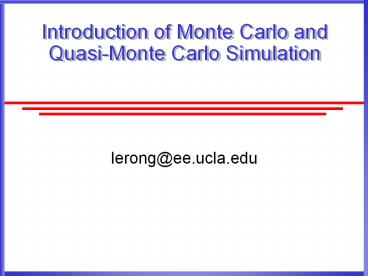Introduction of Monte Carlo and Quasi-Monte Carlo Simulation - PowerPoint PPT Presentation
Title:
Introduction of Monte Carlo and Quasi-Monte Carlo Simulation
Description:
Title: FPGA Power Reduction Using Configurable Dual-Vdd Author: Fei Li Last modified by: EDA Created Date: 12/26/2003 11:10:25 PM Document presentation format – PowerPoint PPT presentation
Number of Views:135
Avg rating:3.0/5.0
Title: Introduction of Monte Carlo and Quasi-Monte Carlo Simulation
1
Introduction of Monte Carlo and Quasi-Monte Carlo
Simulation
- lerong_at_ee.ucla.edu
2
Monte Carlo Simulation
- Problem Formulation
- Given a set of random variables X(X1, X2, Xn)T
and a function of X, Yf(X), estimate the
distribution of the Y - Method
- Generate N samples of X(X1, X2, Xn)T
- For each sample of X, calculate the correspondent
sample of Yf(X) - Obtain the distribution of Y from the samples of
Y
3
Advantage and Disadvantage of MC simulation
- Advantage
- Accurate
- Error?0 when N?8
- Flexible
- Works for any arbitrary distribution of X
- Works for any arbitrary function of f
- Simple
- Easy to implement
- Usually used as golden case in statistical
analysis - Disadvantage
- Not efficient
- Need large N to obtain high accuracy
- Need to run large number of iterations
- Not suitable for statistical optimization
4
Example
- Given X1 and X2 are independent standard Gaussian
RVs, estimate the distribution of max(X1, X2)
5
Quasi Monte Carlo Simulation
- Basic idea
- Use deterministic samples instead of pure random
samples - Select deterministic samples to cover the whole
sample space evenly
6
Discrepancy
- Definition
- N is total number of samples, A(B, P) is the
number of points in bounding box B, ?s(B) is the
volume of B - Discrepancy measures how evenly the samples are
in the sample place
7
Low Discrepancy Sequence
- Sample sequence with low discrepancy
- Low discrepancy array generation algorithms
- Faure sequence
- Neiderreiter sequence
- Sobol sequence
- Halton Sequence
8
Example Halton Sequence
- Basic idea
- Choose a prime number as base (let's say 2)
- Write natural number sequence 1, 2, 3, ... in
base - Reverse the digits, including the decimal sign
- Convert back to base 10
- 1 1.0 gt 0.1 1/2
- 2 10.0 gt 0.01 1/4
- 3 11.0 gt 0.11 3/4
- 4 100.0 gt 0.001 1/8
- 5 101.0 gt 0.101 5/8
- 6 110.0 gt 0.011 3/8
- 7 111.0 gt 0.111 7/8
- High dimensional array
- Use different base for different dimension
- Example 2-d array, X-base 2, y-base 3
- 1 gt x1/2 y1/3
- 2 gt x1/4 y2/3
- 3 gt x3/4 y1/9
- 4 gt x1/8 y4/9
9
Advantage and Disadvantage of QMC Simulation
- Advantage
- Efficient
- Use fewer sample than random Monte Carlo
simulation - Disadvantage
- Only works in low dimension cases
- Very slow when number of random variations become
large - Not very common in statistical analysis
10
Comparison of MC and QMC
- QMC converges faster than MC
11
Simple Project
- Use Quasi MC simulation to estimate the mean of
output delay of the following circuit - Assume 3 variation sources with Normal
distribution - Leff
- Vth
- Tox
- Gate delay is linear function of variation
sources - Implement a Quasi-Monte Carlo sequence generator































